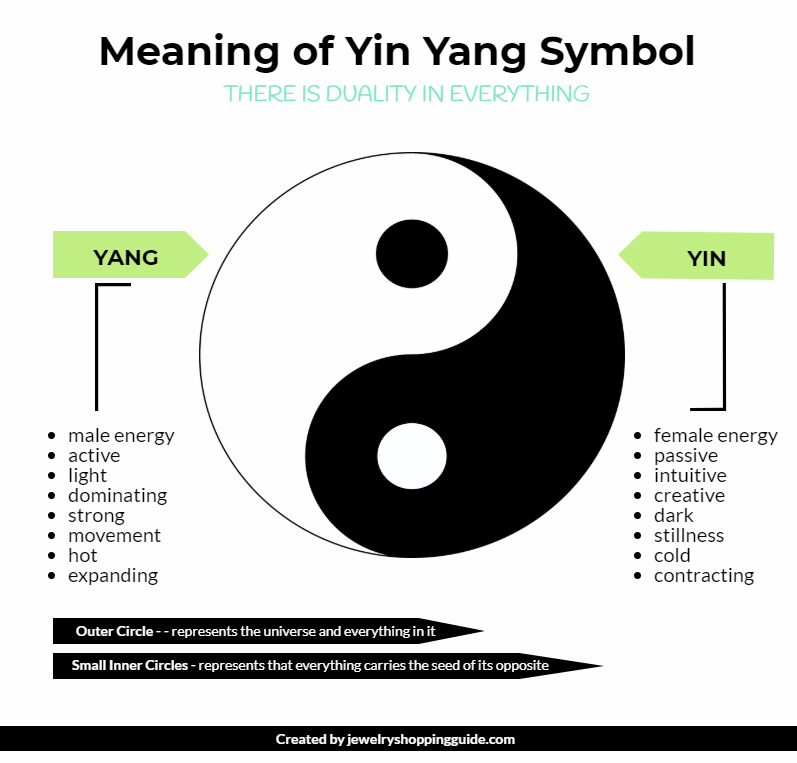

The cycles in nature respond to energies engaging the moment, the elements, and circumstances. The balance between Heaven and Earth is the ultimate balance of Yin Yang. “The Western mindset has a tendency to perceive division and separation, which may cause us to falsely view the world around us through divisions and separations rather than relations and connections.” The Perfect Heaven-Earth Balance Thus, it’s easy to recognize Yin Yang in action as daylight becomes night and continues the cycle of days. In your mind, you can easily see the earth rotating and know that when it is daylight –Yang, for us, it is nighttime –Yin, for those on the other side of the planet. Without Yin, Yang cannot exist, and vise versa. Yang represents a respectable personality type.Īs you may be able to sense from the above explanation, each expression of Yin has a counter or opposite expression of Yang. Yang energy, on the other hand, is masculine, but not macho and not male - it is warm, bright, expanding, and unconcealed.

Yin represents a scoundrel personality type. We may consider Yin as feminine energy, but it is not female - it is cool, dark, contracting, and concealed. Payal Gidwani Tiwari quoted by K.The interactions of Yin Yang are far-reaching constantly changing, moving, and evolving. Couple yoga, through some simple asanas, helps fine-tune your connection with your partner.” Both parents have to be involved in the pregnancy. With nuclear families and with both partners working, pregnancy and a baby can change the balance. “One chapter in the book is dedicated to Yin Yang yoga, also called couple yoga. “Many people choose to get a yin-yang-style koi tattoo, representing balance.” They may also simply use it as a shorthand for the symbol taijitu itself.

Westerners may use yin-yang in discussing concepts of balance and harmony in their practice of Eastern philosophical or medicinal traditions such as Tai Chi, feng shui, or acupuncture. We are ying and yang standing two different generationsĮverything in life is a yin-yang. In contemporary English, yin-yang (or yin and yang) is casually used to describe any two opposites seen to balance each other out or to characterize life’s ups and downs.Īlways takes a toll on me talking to my uncle especially when he goes "Sometimes I feel like you're my only friend" because honestly he is mine too. Like other religious and astrological emoji such as the om symbol, the yin-yang emoji appears as white on a purple square. Unicode 1.0 approved the yin-yang symbol for computers in 1993 and added it to its Emoji 1.0 set in 2015. The term yin-yang is first found in English in the 1850s, and it spread in the 20th century especially thanks to interest in Eastern philosophy, non-Western medicine, and martial arts. In the symbol, yin is represented by the color black and yang, white. their interrelationship came to be depicted in the taijitu, or “Diagram of the Great Ultimate”-better known by Westerns as the yin-yang symbol, first appearing in the 1000s CE and attributed to the philosopher Zhou Dunyi. The balance of yin and yang were seen to influence health and order within an individual, society, and the entire universe.Īnd. Yang (“sun” or “male”) represents light, masculinity, activity, and the heavens. Yin, Chinese for “female” or “moon,” represents darkness, femininity, passivity, and the earth. The school focused around the idea that all life revolved around five basic elements (metal, wood, water, fire, and earth), governed by the forces of yin and yang, part of the qi, or vital life force, of the cosmos. Sometime between roughly 700–400 BCE, Yin-yang was the name of a school of teaching, with chief thinker: alchemist Zou Yan. One of the first mentions of yin-yang for the concept of cosmic harmony comes from a verse in the Shih Ching, a 6th-century BCE collection of poems compiled by Confucius. The concepts of yin and yang have been around since at least the 1300s b.c., when they were found referenced in inscriptions related to Chinese divination of the weather.


 0 kommentar(er)
0 kommentar(er)
